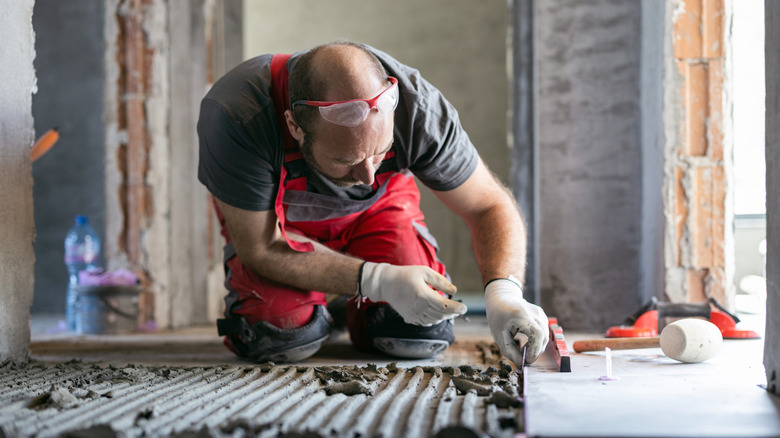The Serious Flooring Mistake You Should Never Make According To HGTV's Mike Holmes
Cutting corners during home renovations often leads to more harm than good. This is especially true when you are updating your flooring. "Holmes Family Rescue" host Mike Holmes has strong opinions about one common shortcut first-time homeowners often make: installing new tile over existing tile flooring. People tend to do this, thinking it saves them time and effort, but Holmes believes it's one of the home upgrades that are a waste of money. In an Instagram post, he shared a warning against this practice: "Always remove the old floor before installing the new floor. Ceramic is heavy. Add on top of that a completely new floor, and you've got a very heavy load."
According to Holmes, the additional weight becomes a problem if one's home is built to a minimum code. Additionally, this can cause issues in moisture-prone areas like bathrooms and kitchens since the new homeowners wouldn't be able to detect previous damage or any surface instability with the first layer. "Some homeowners and contractors think you can lay your new tile directly over your existing tile to save some time. Why do I hate this? Well, for one thing, you're just asking for your new tile and grout to crack — so that brand-new floor isn't going to keep its look for very long," Holmes said, adding that by skipping removal, homeowners lose the chance to inspect and repair their subfloor and prevent moisture and mold from remaining hidden.
Why tiling over existing tile is a recipe for trouble
There are structural and practical reasons why tiling over an existing tile floor should be avoided. As pointed out by Holmes, one major reason is the weight the new layer adds. This added weight translates to an increase in the thickness of the flooring, which can compromise the structural integrity of the floor and the surrounding walls. The original flooring was made to provide enough clearance for door openings, fittings, and furniture. With the new layer, this clearance is reduced, possibly causing some doors and fittings to jam.
Another issue lies in the potential bonding failure of the second layer of tiles. For tile adhesive to create a durable connection with the new tile layer, it needs to bind securely to the surface below. If the existing layer is made of glazed tiles or those with a polished, nonporous finish, the adhesive will struggle to bind to the surface. Small dips or uneven grout lines from the first layer can cause the same problem. Worse, it can lead to cracks or lifting shortly after the new layer's installation.
Finally, installing new tile over existing tile flooring without a waterproof membrane can conceal the hidden dangers that come with trapped moisture. Mold can lurk in the most unexpected places inside the home where there's trapped moisture, and it can go unnoticed until costly damage occurs.
When (and only when) you can tile over tile
Although tiling over existing tile is one of the biggest mistakes to avoid when tiling, there are rare cases when this can still be done. If you are considering this flooring shortcut, it's important to assess your current tile floor's stability and surface condition. It should be flat, level, and securely bonded to the subfloor and walls. A physical inspection can determine the first two, while the third, you can test by lightly tapping the existing tile with a mallet. Any hollow sounds indicate looseness and instability.
If the original tile layer passes the stability check, the next thing to consider is elevation. Increasing your floor height will directly affect door clearances, baseboards, and flooring transitions between spaces. Adjustments will be necessary to accommodate the elevation, such as trimming the doors and modifying cabinetry and fittings. Additionally, you need to rule out moisture issues before proceeding. You can check for leaks or trapped dampness using a moisture meter.
If all conditions are met, you can move forward with installing a second layer of tile on your floor. Be sure to use primers and specialized bonding agents so the new layer can securely adhere to the floor. If you are not confident in your flooring skills, however, it is better to hire experienced and professional tile installers. Tiling over existing tile is generally not recommended because of its risks. To lower such risks and prevent future issues, let an expert take charge.


